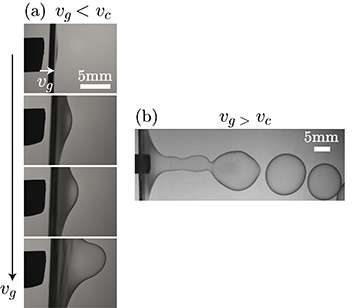Soap bubbles' secrets go pop

Some phenomena that appear to be well understood are much more mysterious than it seems. In spite of the numerous applications that rely on the presence or absence of bubbles, no advanced scientific studies had been carried out so far into how bubbles form. A team of researchers in the Matière Molle Department at the Institut de Physique de Rennes (CNRS/Université Rennes) tackled this question and developed a self-sustaining bubble machine in the laboratory. The researchers have managed to determine the minimum speed at which air must be blown on a soap film to form bubbles, under various experimental conditions. This work, which would allow optimization of various industrial processes, was published on February 19, 2016 in Physical Review Letters.
Many natural phenomena and industrial processes, such as foam production, require the formation of thin liquid films, while others require the opposite: preventing bubbles from forming. The latter include glass making and depositing liquid coatings onto plates or fibers. To study soap bubble formation in the laboratory, researchers developed an experimental bubble machine that can produce long-lived thin liquid films.
A tank placed above the setup lets a soap solution flow between two stretched nylon wires. The liquid flows under gravity, and is then pumped back to the tank. When the two wires, each about one meter long, are separated, they form a rectangular soap film. An "artificial mouth" made of a needle connected to a pressure regulator mimics human breathing. At low speed, the gas jet deforms the film and creates a cavity that becomes thinner as the gas rate increases, until the rate reaches the threshold for bubble formation. These rapid phenomena, which are difficult to see with the naked eye, are revealed when filming the experiments with a high-speed camera.
The researchers thus modeled the results as a function of the different experimental configurations. They have identified the key physical factors that control the minimum breathing speed for generating bubbles on a soap film. The team also characterized the influence of the distance separating the "mouth" from the film on bubble formation, then observed that the velocity and thickness of the soap film did not impact bubble production under the conditions studied.
So this work produces excellent data for bubble size and formation frequency measurement. This may help to optimize diverse industrial processes.
More information: Louis Salkin et al. Generating Soap Bubbles by Blowing on Soap Films, Physical Review Letters (2016). DOI: 10.1103/PhysRevLett.116.077801
Journal information: Physical Review Letters
Provided by CNRS














.jpg)





